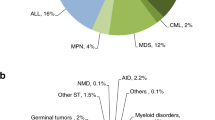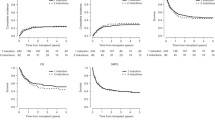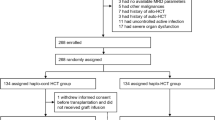Cord blood transplantation: rewind to fast forward
The utilization of cord blood as a source of stem cells for transplantation has decreased in recent years. Although cord blood transplantation (CBT) is an established practice for the treatment of adult and pediatric patients with hematological malignancies, the high acquisition cost of CB units along with high transplant-related mortality due to delayed hematopoietic recovery and immune reconstitution have contributed to the slowing in widespread adoption of CBT. Strategies aimed to enhance speed of engraftment and ongoing clinical trials are investigating ways to make CBT more widely available. Meanwhile, the recent clinical data suggest that the choice of CBT might be preferable for patients with pre-transplant minimal residual disease. We review here the background data on the utilization of CB for the treatment of hematological malignancies, and discuss the current challenges and future directions in the field of CBT.
This is a preview of subscription content, access via your institution
Access options
Subscribe to this journal
Receive 12 print issues and online access
265,23 € per year
only 22,10 € per issue
Buy this article
- Purchase on SpringerLink
- Instant access to full article PDF
Prices may be subject to local taxes which are calculated during checkout
Similar content being viewed by others

Hematopoietic cell transplantation and cellular therapy survey of the EBMT: monitoring of activities and trends over 30 years
Article Open access 23 February 2021

Outcome of human umbilical cord blood stem cell transplantation (CBT) for acute myeloid leukemia in patients achieving first complete remission after one versus two induction courses: a study from the Acute Leukemia Working Party of the European Society for Blood and Marrow Transplantation (EBMT)
Article 30 June 2022

Haploidentical hematopoietic cell transplantation with or without an unrelated cord blood unit for adult acute myeloid leukemia: a multicenter, randomized, open-label, phase 3 trial
Article Open access 06 May 2024
References
- Laughlin MJ, Barker J, Bambach B, Koc O, Rizzieri D, Wagner J et al. Hematopoietic engraftment and survival in adult recipients of umbilical-cord blood from unrelated donors. N Engl J Med 2001; 344: 1815–1822. ArticleCASPubMedGoogle Scholar
- Laughlin MJ, Eapen M, Rubinstein P, Wagner J, Zhang M, Champlin R et al. Outcomes after transplantation of cord blood or bone marrow from unrelated donors in adults with leukemia. N Engl J Med 2004; 351: 2265–2275. ArticleCASPubMedGoogle Scholar
- Rocha V, Labopin M, Sanz G, Arcese W, Schwerdtfeger R, Bosi A et al. Transplants of umbilical-cord blood or bone marrow from unrelated donors in adults with acute leukemia. N Engl J Med 2004; 351: 2276–2285. ArticleCASPubMedGoogle Scholar
- Kurtzberg J, Laughlin M, Graham M, Smith C, Olson J, Halperin E et al. Placental blood as a source of hematopoietic stem cells for transplantation into unrelated recipients. N Engl J Med 1996; 335: 157–166. ArticleCASPubMedGoogle Scholar
- Barker J, Byam C, Kernan N, Lee S, Hawke R, Doshi K et al. Availability of cord blood extends allogeneic hematopoietic stem cell transplant access to racial and ethnic minorities. Biol Blood Marrow Transplant 2010; 16: 1541–1548. ArticlePubMedPubMed CentralGoogle Scholar
- Gragert L, Eapen M, Williams E, Freeman J, Spellman S, Baitty R et al. HLA match likelihoods for hematopoietic stem-cell grafts in the U.S. registry. N Engl J Med 2014; 371: 339–348. ArticleCASPubMedPubMed CentralGoogle Scholar
- Eapen M, Rubinstein P, Zhang M, Stevens C, Kurtzberg J, Scaradavou A et al. Outcomes of transplantation of unrelated donor umbilical cord blood and bone marrow in children with acute leukaemia: a comparison study. Lancet 2007; 369: 1947–1954. ArticlePubMedGoogle Scholar
- Brunstein C, Gutman J, Weisdorf D, Woolfrey A, Defor T, Gooley T et al. Allogeneic hematopoietic cell transplantation for hematologic malignancy: relative risks and benefits of double umbilical cord blood. Blood 2010; 116: 4693–4699. ArticleCASPubMedPubMed CentralGoogle Scholar
- Atsuta Y, Morishima Y, Suzuki R, Nagamura-Inoue T, Taniquchi S, Takahashi S et al. Comparison of unrelated cord blood transplantation and HLA-mismatched unrelated bone marrow transplantation for adults with leukemia. Biol Blood Marrow Transplant 2012; 18: 780–787. ArticlePubMedGoogle Scholar
- Ponce D, Gonzales A, Lubin M, Castro-Malaspina H, Giralt S, Goldberg J et al. Graft-versus-host disease after double-unit cord blood transplantation has unique features and an association with engrafting unit-to-recipient HLA match. Biol Blood Marrow Transplant 2013; 19: 904–911. ArticleCASPubMedPubMed CentralGoogle Scholar
- Newell L, Flowers M, Gooley T, Milano F, Carpenter P, Martin P et al. Characteristics of chronic GVHD after cord blood transplantation. Bone Marrow Transplant 2013; 48: 1285–1290. ArticleCASPubMedPubMed CentralGoogle Scholar
- Broxmeyer H, Kurtzberg J, Gluckman E, Auerbach A, Douglas G, Cooper S et al. Umbilical cord blood hematopoietic stem and repopulating cells in human clinical transplantation. Blood Cells 1991; 17: 313–329. CASPubMedGoogle Scholar
- Broxmeyer HE, Hangoc G, Cooper S, Ribeiro R, Graves V, Yoder M et al. Growth characteristics and expansion of human umbilical cord blood and estimation of its potential for transplantation in adults. Proc Natl Acad Sci USA 1992; 89: 4109–4113. ArticleCASPubMedPubMed CentralGoogle Scholar
- Gluckman E, Broxmeyer H, Auerbach A, Friedman H, Douglas G, Devergie A et al. Hematopoietic reconstitution in a patient with Fanconi’s anemia by means of umbilical-cord blood from an HLA-identical sibling. N Engl J Med 1989; 321: 1174–1178. ArticleCASPubMedGoogle Scholar
- Brunstein C, Fuchs E, Carter S, Karanes C, Costa L, Devine S et al. Alternative donor transplantation after reduced intensity conditioning: results of parallel phase 2 trials using partially HLA-mismatched related bone marrow or unrelated double umbilical cord blood grafts. Blood 2011; 118: 282–288. ArticleCASPubMedPubMed CentralGoogle Scholar
- Majhail N, Mothukuri J, Brunstein C, Weisdorf D . Costs of hematopoietic cell transplantation: comparison of umbilical cord blood and matched related donor transplantation and the impact of posttransplant complications. Biol Blood Marrow Transplant 2009; 15: 564–573. ArticlePubMedGoogle Scholar
- Barker J, Weisdorf D, DeFor T, Blazar B, McGlave P, Miller J et al. Transplantation of 2 partially HLA-matched umbilical cord blood units to enhance engraftment in adults with hematologic malignancy. Blood 2005; 105: 1343–1347. ArticleCASPubMedGoogle Scholar
- Varnum-Finney B, Xu L, Brashem-Stein C, Nourigat C, Flowers D, Bakkour S et al. Pluripotent cytokine-dependent, hematopoietic stem cells are immortalized by constitutive Notch1 signaling. Nat Med 2000; 6: 1278–1281. ArticleCASPubMedGoogle Scholar
- Varnum-Finney B, Wu L, Yu M, Brashem-Stein C, Staats S, Flowers D et al. Immobilization of Notch ligand, Delta-1 is required for induction of notch signaling. J Cell Sci 2000; 113: 4313–4318. CASPubMedGoogle Scholar
- Delaney C, Heimfeld S, Brashem-Stein C, Voorhies H, Manger R, Bernstein I . Notch-mediated expansion of human cord blood progenitor cells capable of rapid myeloid reconstitution. Nat Med 2010; 16: 232–236. ArticleCASPubMedPubMed CentralGoogle Scholar
- Milano F, Heimfeld S, Riffkin I, Nicoud I, Appelbaum F, Bernstein I et al. Infusion of a non HLA-matched off-the-shelf ex-vivo expanded cord blood progenitor cell product following myeloablative cord blood transplantation is safe, decreases the time to hematopoietic recovery, and results in excellent overall survival. Blood 2014; 124: 46. Google Scholar
- Thompson P, Rezvani K, Hosing C, Oran B, Olson A, Popat U et al. Umbilical cord blood graft engineering: challenges and opportunities. Bone Marrow Transplant 2015; 50: S55–S62. ArticlePubMedGoogle Scholar
- Ballen KK, Gluckman E, Broxmeyer HE . Umbilical cord blood transplantation: the first 25 years and beyond. Blood 2013; 122: 491–498. ArticleCASPubMedPubMed CentralGoogle Scholar
- Dahlberg A, Delaney C, Bernstein ID . ex vivo expansion of human hematopoietic stem and progenitor cells. Blood 2011; 117: 6083–6090. ArticleCASPubMedPubMed CentralGoogle Scholar
- Cutler C, Multani P, Robbins D, Kim H, Hoggat J, Pelus L et al. Prostaglandin-modulated umbilical cord blood hematopoietic stem cell transplantation. Blood 2013; 122: 3074–3081. ArticleCASPubMedPubMed CentralGoogle Scholar
- Farag S, Srivastava S, Messina-Graham S, Schwartz J, Robertson M, Abonour R et al. In vivo DPP-4 inhibition to enhance engraftment of single-unit cord blood transplants in adults with hematological malignancies. Stem Cells Dev 2013; 22: 1007–1015. ArticleCASPubMedGoogle Scholar
- Capitano M, Hangoc G, Cooper S, Broxmeyer H . Mild heat treatment primes human CD34+ cord blood cells for migration towards SDF-1α and enhances engraftment in an NSG mouse model. Stem Cells 2015; 33: 1975–1984. ArticleCASPubMedPubMed CentralGoogle Scholar
- Popat U, Mehta R, Rezvani K, Fox P, Kondo K, Marin D et al. Enforced fucosylation of cord blood hematopoietic cells accelerates neutrophil and platelet engraftment after transplantation. Blood 2015; 125: 2885–2892. ArticleCASPubMedPubMed CentralGoogle Scholar
- de Lima M, McNiece I, Robinson S, Munsell M, Eapen M, Horowitz M et al. Cord-blood engraftment with ex vivo mesenchymal-cell coculture. N Engl J Med 2012; 367: 2305–2315. ArticleCASPubMedPubMed CentralGoogle Scholar
- Horwitz M, Chao N, Rizzieri D, Long G, Sullivan K, Gasparetto C et al. Umbilical cord blood expansion with nicotinamide provides long-term multilineage engraftment. J Clin Invest 2014; 124: 3121–3128. ArticleCASPubMedPubMed CentralGoogle Scholar
- Boitano A, Wang J, Romeo R, Bouchez L, Parker A, Sutton S et al. Aryl hydrocarbon receptor antagonists promote the expansion of human hematopoietic stem cells. Science 2010; 329: 1345–1348. ArticleCASPubMedPubMed CentralGoogle Scholar
- Wagner J, Brunstein C, Boitano A, DeFor T, McKenna D, Sumstad D et al. Phase I/II trial of StemRegenin-1 expanded umbilical cord blood hematopoietic stem cells supports testing as a stand-alone graft. Cell Stem Cell 2016; 18: 144–155. ArticleCASPubMedGoogle Scholar
- Wagner J, Eapen M, Carter S, Wang Y, Schultz K, Wall D et al. One-unit versus two-unit cord-blood transplantation for hematologic cancers. N Engl J Med 2014; 371: 1685–1694. ArticleCASPubMedPubMed CentralGoogle Scholar
- Milano F, Gooley T, Wood B, Woolfrey A, Flowers M, Doney K et al. Cord-blood transplantation in patients with minimal residual disease. N Engl J Med 2014; 375: 944–953. ArticleGoogle Scholar
- Verneris M, Brunstein C, Barker J, MacMillan M, Defor T, McKenna D et al. Relapse risk after umbilical cord blood transplantation: enhanced graft-versus-leukemia effect in recipients of 2 units. Blood 2009; 114: 4293–4299. ArticleCASPubMedPubMed CentralGoogle Scholar
- Sun J, Kurtzberg J . Cord blood for brain injury. Cytotherapy 2015; 17: 775–785. ArticlePubMedGoogle Scholar
Author information
Authors and Affiliations
- Clinical Research Division, Fred Hutchinson Cancer Research Center, Seattle, WA, USA A Dahlberg & F Milano
- Department of Pediatrics, University of Washington, Seattle, WA, USA A Dahlberg
- Department of Medicine, University of Washington, Seattle, WA, USA F Milano
- A Dahlberg




